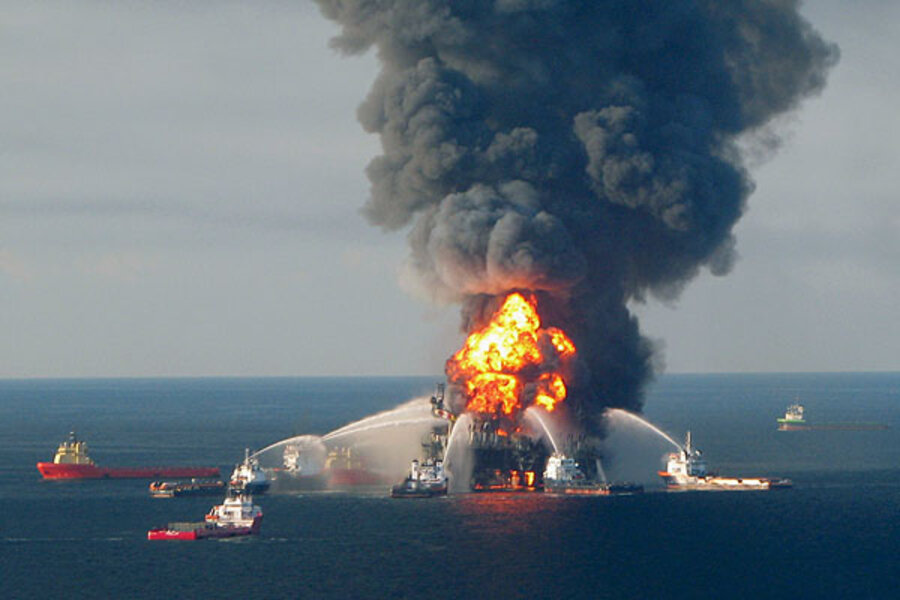Mystery in Gulf of Mexico: Why is oil leaking from Deepwater disaster site?
Loading...
| Chicago
Oil is leaking into the Gulf of Mexico at the rate of about 100 gallons per day near the Macondo wellhead, the site of the oil spill over two years ago that became the worst environmental disaster in US history.
The US Coast Guard reports that the oil has been leaking since at least Sept. 16, when satellite images first revealed a sheen of surface oil located about 50 miles off the Louisiana coast and in the vicinity of where the Deepwater Horizon oil rig exploded on April 20, 2010, killing 11 people.
Five million barrels of oil, or 205 million gallons, were released into the Gulf in the three months following the explosion.
The sheen has varied in size since its detection. Samples taken to Coast Guard laboratories in Morgan City, La., and New London, Conn., concluded the oil originated from the Macondo well.
On Sunday, the Coast Guard dispatched remotely operated vehicles to collect oil samples from the underwater site. The agency reported on Wednesday it suspected the oil was leaking from a discarded containment dome, one of several technologies used to contain the original oil spill. The dome is located about 1,600 feet from the Macondo site.
In a statement, Capt. Duke Walker, on-scene coordinator for the Coast Guard, said the agency “is further evaluating what is believed to be seepage from the containment dome to determine how best to respond.” The Coast Guard is not yet specifying how the oil could be seeping from the dome or what may be causing it to do so now.
BP, the British oil giant responsible for the 2010 drilling operation, reports that the Macondo wellhead remains sealed since it was permanently capped with cement in mid-September 2010. The Coast Guard’s underwater inspection Sunday double-checked the wellhead as well as residual wreckage from the explosion.
The containment dome, standing four stories high and weighing 98 tons, was lowered 5,000 feet below the water’s surface to the ocean’s floor on May 6, 2010, just weeks after the explosion. The device was originally meant as a temporary measure to contain the gushing oil from one of two main leaks while recovery crews worked to plug the well. The dome’s design allowed oil and gas to flow through a pipe to a surface vessel.
Five days later, however, the dome failed after methanol, combined with freezing undersea water, crystallized in the dome, making it buoyant. Filled with flammable material, the device floated to the surface, but engineers later manipulated it so it could rest safely on the ocean’s floor.
Following the oil spill, the Obama administration issued stricter regulations for companies drilling in the deep waters of the Gulf, which is the largest source of domestic oil in the US. Despite a temporary moratorium on drilling in the region in the immediate aftermath of the disaster, permits for drilling new wells in water deeper than 500 feet are up to pre-disaster levels.
According to the US Bureau of Safety and Environmental Enforcement, the agency tasked with regulating offshore drilling, the US has to date issued 89 permits this year, more than all the permits issued (76) in 2009, one year before the disaster. The agency’s website reports that 32 permits were issued in 2010 and 38 in 2011.
The issue of drilling on federal lands became a contentious issue in Tuesday’s debate between Republican presidential candidate Mitt Romney and President Obama. In the debate, Mr. Romney accused the president of slashing permits for drilling in half during his administration. Mr. Obama denied the accusation.
The increased pace of permitting has pleased some oil and gas industry analysts, who say the administration is on the right path.
“We’re just now seeing the permitting return to pre-Macondo levels,” Andy Lipow, president of the Houston-based consulting firm Lipow Oil Associates LLC, told Bloomberg News Wednesday. “With oil prices hovering around $90 to $100 a barrel, it makes sense to look for oil in that area.”






